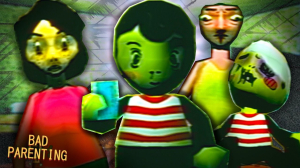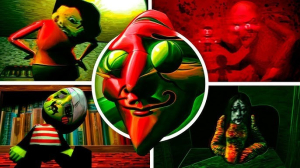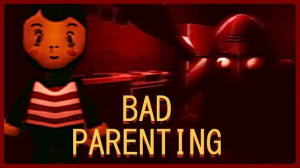


From the moment I booted up Bad Parenting 1: Mr. Red Face, I felt as if I had stepped into a world where disorder and quirkiness ruled every aspect of life. I approached the game with a curious mind and a sense of anticipation, expecting a blend of satire and unconventional storytelling that defies the typical video game formula. In this adventure, I was not merely an observer; I fully immersed myself in the role of someone responsible for a unique brand of mismanagement and chaos. The initial moments of the game set the tone for an experience that was both comical and sharply critical of absurd norms. I entered a vibrant universe where each misstep, challenge, and encounter was designed to force me to reconsider what it meant to be a figure of authority, albeit in an unconventional sense.
The Unpredictable Flow of Gameplay Mechanics
What truly captivated me about Bad Parenting 1 was its gameplay mechanics that playfully subverted expectations. As I navigated through a series of tasks that were both whimsical and demanding, I found a narrative woven tightly with challenging puzzles and delightful mini-games. Rather than following a linear path, the game presented me with multiple objectives that sometimes felt more like experiments in chaos management. Each segment was meticulously designed so that even though failures were common, they also led to opportunities to explore further elements of the intricate game world. The mechanics not only tested my adaptability but also encouraged me to think creatively as I juggled responsibilities and resisted the pull of convention.
A Blend of Humor and Satirical Undertones
The humor in Bad Parenting 1 is not simply a collection of one-liners or slapstick moments; rather, it is deeply interwoven with its satirical portrayal of societal norms. Playing as Mr. Red Face, I experienced dialogue and circumstances brimming with layers of absurdity that hinted at a broader commentary on family dynamics and societal expectations. The humor, though light-hearted on the surface, carried an undertone of critique that resonated with current debates about authority and responsibility. It was impossible not to appreciate how cleverly everyday frustrations were transformed into opportunities for absurd yet thought-provoking amusement. The game used clever wordplay and unpredictable scenarios that kept me both laughing and reflecting on how easily chaos can be masked under humor.
Visual Design and Artistic Flair
One of the first things that struck me was the art style of Bad Parenting 1. The graphics embraced a cartoonish aesthetic that felt both intentionally rough around the edges and artistically bold. The character designs were exaggerated and full of personality, capturing the essence of flawed but endearing personas. I found that each visual element, from the quirky animation to the expressive facial features of Mr. Red Face, contributed to the overall experience. The vibrant color palette brought life to the various environments in a way that made even the most chaotic moments visually engaging. The game’s balance between simplicity and detail allowed me to enjoy an experience that was visually memorable without getting lost in overly complex graphics.
Auditory Experience: Music and Sound Design
The auditory elements of the game were equally impressive. I was drawn into a soundscape where a mix of upbeat tunes and ironic sound effects played an essential role in reinforcing the game’s themes. The background tracks managed to evoke both a sense of urgency and a wry amusement, perfectly offsetting the misadventures unfolding on screen. Every sound effect was carefully placed to accentuate actions, whether it was a subtle laugh track accompanying a clumsy move or an unexpected musical cue that paralleled a particularly humorous fail. The balance of audio cues and ambient sounds created an immersive environment, making each moment feel both personal and surreal. I found myself replaying certain sequences just to soak in the intricacies of the auditory design.
Taking On the Role of a Chaotic Caretaker
Playing as Mr. Red Face meant stepping into the shoes of a character who was anything but ordinary. I experienced firsthand how the game challenges preconceptions about leadership and responsibility, and how every decision had a humorous backlash. The character’s unpredictable reactions and the way he managed his responsibilities provided a unique perspective that diverged from the norm often found in conventional games. This role was surprisingly liberating because it allowed me to experiment with unconventional strategies without fear of irreversible setbacks. The game encouraged experimentation by presenting a series of cascading events where one mismanaged decision led to another, each with its own comic twist. This constant push and pull between cause and effect made my journey both unpredictable and thoroughly engaging.
Complex Quests and Creative Puzzle Design
The quest structure of Bad Parenting 1 was one of the game’s standout features. I encountered a series of tasks that felt less like chores and more like clever challenges that required a good dose of lateral thinking. Each challenge was designed to make me evaluate my approach and to switch tactics at the slightest hint of monotony. I found that the game rewarded creative problem-solving by throwing curveballs that broke away from traditional puzzle-solving techniques. Whether it was managing a minor household crisis or dealing with an unexpected twist in the narrative, every quest invited me to explore different angles and to appreciate the underlying wit of the design. In these moments, my choices directly influenced the unfolding events, reminding me that success in this chaotic environment was less about perfection and more about resilience and adaptability.
Exploring the Intricacies of Narrative Threads
Delving into the story of Bad Parenting 1 has been an engaging experience that felt both fragmented and multi-layered. The narrative is not a straightforward tale but an assemblage of incidents that work together to paint a picture of absurdity and flawed ideals. I experienced dialogues that ranged from mundane to outrageously whimsical, all while carrying hints of a deeper commentary on societal expectations. The narrative allowed me to form personal interpretations and connections with the unfolding events. Each scene was punctuated with a sense of ironic self-awareness, prompting me to evaluate the humor and the chaos from a variety of angles. This branching narrative ensured that no two play sessions felt identical, and I often found myself uncovering new narrative threads in practices that had initially seemed repetitive.
Balancing Chaos with Methodical Controls
On a deeper level, I appreciated the balance between chaos and structure in the game’s design. Bad Parenting 1 did not simply rely on random mishaps to propel the storyline; it also provided a set of methodical controls that allowed me to manage, albeit imperfectly, the chaotic situations presented. The interface was designed to be both accessible and reflective of the game’s underlying humor, featuring mechanics that were intuitive even if the outcomes were unpredictably humorous. I found that the controls, though simple at first glance, offered layers of depth that increased the satisfaction of overcoming obstacles. The juxtaposition of a rigid control system with a narrative that purposefully celebrated disorder was a clever twist, keeping my interest alive throughout the gameplay sessions.
The Role of Environment in Crafting the Experience
The environment within Bad Parenting 1 served as more than just a backdrop for the unfolding drama; it was a character in its own right. As I navigated different settings—from cluttered living areas dripping with personality to chaotic outdoor scenes that felt almost alive—the game continuously reminded me that every detail was an intentional part of the experience. The artful design of these spaces, together with interactive elements hidden in plain sight, added an extra layer of entertainment. I enjoyed uncovering little surprises around corners, small details that would spark a moment of amusement or spark a reflection on the nature of chaos within everyday life. The interplay between the environment and the tasks provided a level of immersion that elevated casual gameplay into an experience rich with narrative textures.
User Interface and Interactive Layering
As I progressed through the game, I was consistently impressed by the thoughtful design of the user interface. The interaction elements were both clear and playful, leading me through the game without overwhelming me with excessive instructions. I particularly enjoyed how the UI balanced the need for informative guidance with the game’s overall humorous tone. Each button, menu, and indicator appeared as if it were part of the game’s grand joke, inviting me to engage with a system that was at once highly functional and irreverently lighthearted. Navigating through different layers of the game felt like exploring a well-organized studio of chaos, where the playful design of the UI enhanced the underlying theme of disordered order. This careful calibration between ease-of-use and the satirical elements of the narrative made interaction a deeply satisfying part of my overall experience.
Experiencing the Ripple Effects of Every Action
Perhaps one of the most intriguing aspects of my journey was witnessing the ripple effects of every decision I made. The game’s dynamic system ensured that seemingly trivial choices had surprising ramifications, weaving a complex tapestry of cause and effect that kept me on my toes. I found that the consequences of my actions were not confined to a single, isolated moment; rather, they branched out into multiple layers of interaction and story development. This creative design choice bred a sense of continuity that made even the most minor incidents feel significant. I spent countless moments reflecting on how a particular choice, however small it might have seemed, triggered unexpected reactions that both challenged my expectations and added to the overarching theme of delightful disarray. The careful orchestration of these reflective mechanics transformed each play session into an intricate study of actions and responses.
Unexpected Encounters and the Joy of Spontaneity
On several occasions, I was pleasantly surprised by encounters that defied any preconceived logic. The game managed to sprinkle in moments of sheer randomness that, while unpredictable, were perfectly in tune with its chaotic spirit. I encountered characters and scenarios that felt like playful nods to the unpredictable nature of real life, each interaction charged with an energy that was as infectious as it was bizarre. These spontaneous moments allowed me to break away from any rigid plans or strategies I had in mind, encouraging me to embrace the flow of the game. The unpredictability of these encounters, and the responsibility of guiding them to humorous ends, was refreshing. It reminded me that in a game world ruled by whimsical unpredictability, the process of discovery is just as important as the destination itself.
Exploring Replay Value and Hidden Depths
After a lengthy session of managing mayhem and unexpected twists, I realized that the hidden depths of Bad Parenting 1 encouraged me to revisit the game repeatedly. Each replay unlocked a different facet of the narrative and gameplay—a testament to the carefully constructed layering of unexpected events and hidden easter eggs. I found that the game rewarded exploration and experimentation, creating a landscape where every playthrough felt like an entirely new chapter peppered with fresh scenarios. The replay environment was crafted in such a way that the stakes of each decision remained high, regardless of how frequently I restarted a particular mission or challenge. It was this evolving dynamism that made the game more than just a collection of standalone events; it turned every session into a journey of discovery and reinvention, with depth that revealed itself to me over time.
- Engaging and unpredictable gameplay mechanics that constantly challenge expectations
- Clever and satirical humor which offers a refreshing critique of everyday norms
- Unique art style with vibrant graphics that capture the chaotic spirit of the game
- Smooth and immersive sound design that enhances both the narrative and action sequences
- High replay value with hidden details and unexpected layers in each session
- Intuitive user interface that effectively balances functionality with playful design
- A steep learning curve that may deter players accustomed to more conventional game formats
- Narrative threads that can occasionally feel disjointed or overly whimsical
- Intermittent technical quirks that have the potential to disrupt the immersive experience



